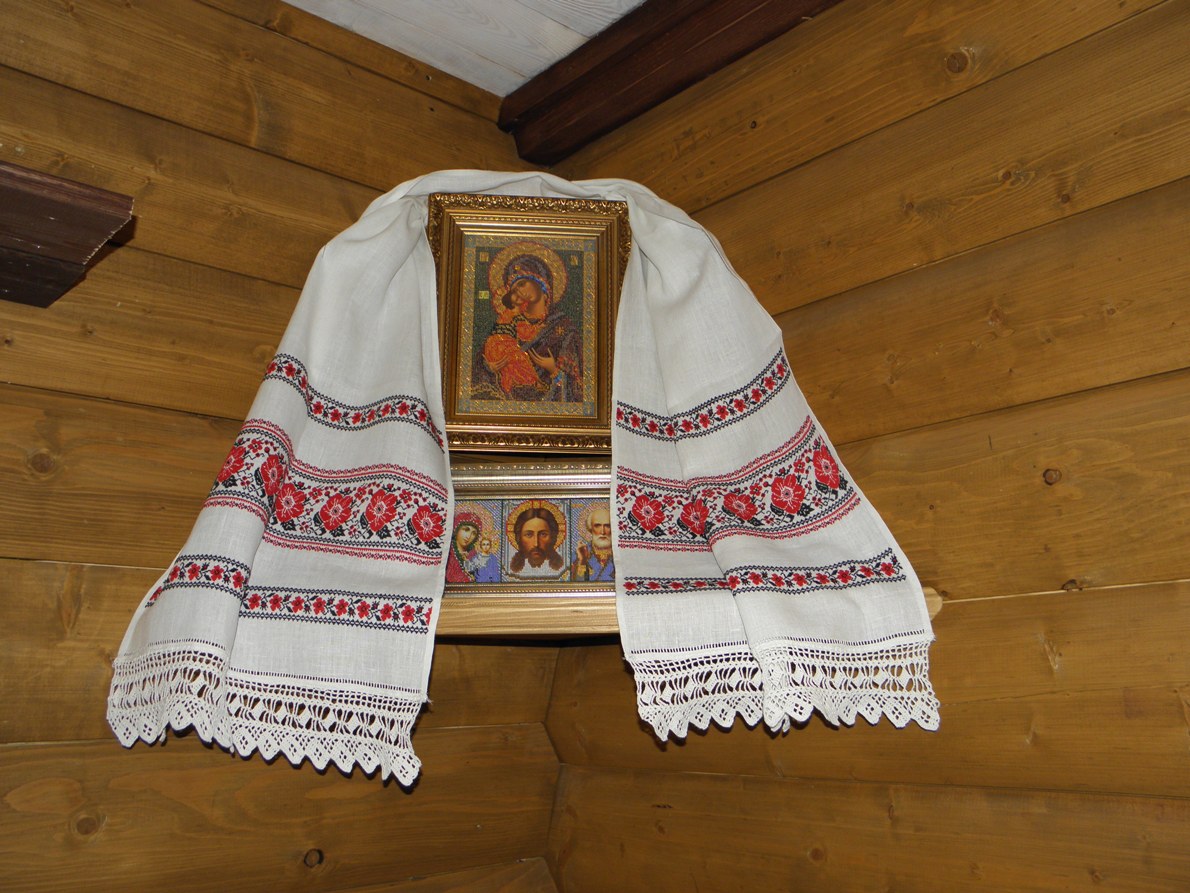 A towel is an ancient attribute that has come down to us from the distant pagan past and is used in various everyday rituals to this day. Since time immemorial, honored and dear guests have been greeted with bread and salt on a beautiful towel, it is used to emphasize the respectful attitude towards icons in most old village huts, it is used at baptisms, during matchmaking and weddings of newlyweds, it is accompanied on long journeys and on the last earthly journey.
A towel is an ancient attribute that has come down to us from the distant pagan past and is used in various everyday rituals to this day. Since time immemorial, honored and dear guests have been greeted with bread and salt on a beautiful towel, it is used to emphasize the respectful attitude towards icons in most old village huts, it is used at baptisms, during matchmaking and weddings of newlyweds, it is accompanied on long journeys and on the last earthly journey.
The meaning of the concept of "towel"
This term refers to a rectangular piece of fabric made from hemp or flax fibers and decorated with a rich, elegant pattern. The pattern is applied to the towel in different ways: either woven during the production of the fabric, or embroidered on the finished canvas. Ethnographers believe that the name "towel" comes from the Ukrainian word "rushnyk", that is, to set off on a journey. Therefore, it probably resembles a road in shape. Other researchers advocate the idea that this name comes from the root of the word "rush", that is, to break, to destroy. This statement is justified by the lack of tools among ancient Ukrainians, because at that time scissors had not yet been invented, and a measured piece of canvas was torn off by hand.
The dimensions of towels in most cases were approximately equal: 35 - 40 cm in width and 1.5 - 5 m in length, depending on the purpose of the product. Towels were decorated not only with rich and beautiful embroidery, but also with braid, ribbons, knitted or woven lace.
Towels were considered the calling card of the housewife: the more of them there were in the house and the more elaborate the patterns on them, the more hardworking the woman and her daughters were considered.
Wedding ceremonies and towels
In ancient times, the custom of preparing towels and an outfit for the bride for the wedding appeared. Moreover, according to the rules that existed at that time, she did it with her own hands and only under certain circumstances resorted to the help of women, but only from her family. Much later, with the division of society into poor and rich, embroiderers began to be hired for a fee, who helped in the manufacture of outfits and towels. The number of towels prepared for the wedding sometimes reached almost fifty, but the ornamental motifs and symbolism of the images were passed down from generation to generation, sacredly honoring and protecting family secrets. Nowadays, everything has become much simpler, and the number of towels has decreased significantly: one is used at the engagement (for binding hands), another is needed in the registry office or church when registering a marriage or wedding, the third is for the wedding loaf, another for the Gospel and for icons.
The most important towel at a wedding is considered to be the towel under the feet. There is a belief that the first of the newlyweds to step on the towel will be the head of the house.
For such a towel, a pattern with geometric or floral ornaments is preferable. In no case could symbolic signs of the newlyweds be depicted on such a towel: a pair of swans or doves, a pair of rings or flowers, since it was believed that they would trample on everything good in their family life.
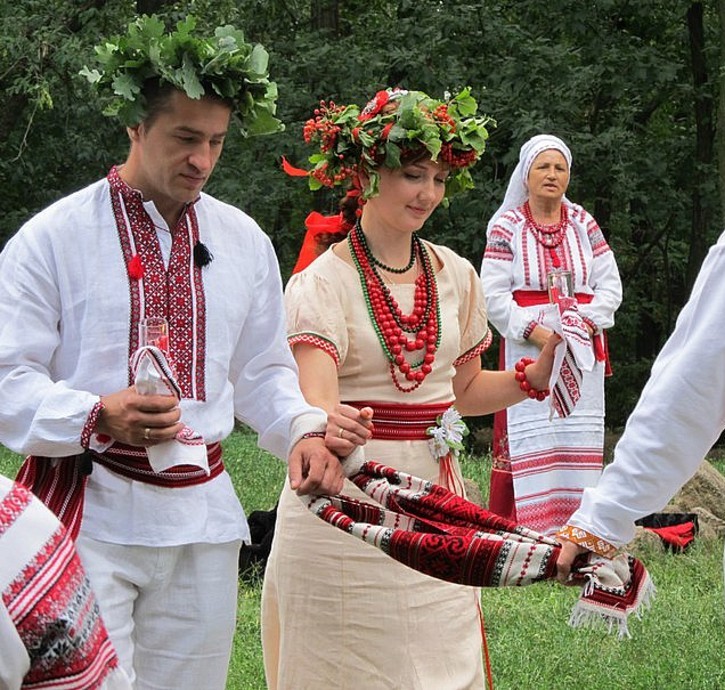 The largest and most beautiful towel at a wedding is the "hand-embroidered" towel. The girl embroidered this towel herself, without resorting to the help of others, and during the matchmaking, her mother gave it to the groom as a sign of approval and consent to the marriage. Witnesses were also tied crosswise at the wedding. Now, in a simplified form, ribbons are used for this.
The largest and most beautiful towel at a wedding is the "hand-embroidered" towel. The girl embroidered this towel herself, without resorting to the help of others, and during the matchmaking, her mother gave it to the groom as a sign of approval and consent to the marriage. Witnesses were also tied crosswise at the wedding. Now, in a simplified form, ribbons are used for this.
In the registry office or church, the hands of the newlyweds are tied with a union towel. This rite signifies family happiness, strong bonds, and unity. Such towels are characterized by the use of white and red colors, sometimes black was added for contrast. There were no restrictions on the choice of pattern; you can use various ornaments, pictures, and add inscriptions and wishes.
A special towel was embroidered for the wedding loaf - the "khlibosolny" (greeting towel). The groom's parents would use it to greet the young couple after the wedding. This towel could feature a pair of swans, doves or larks, wedding rings, and a floral ornament on the sides, symbolizing the well-being and prosperity of the young family.
Thanks to the existing tradition: to bless the newlyweds, there is a special type of towel - "bozhnik". They decorate special corners in the house, framing the icons placed there. As a rule, floral ornaments were embroidered on them, and a prayer was said before starting work. According to the depicted pattern, it was possible to determine which of the newlyweds the towel belonged to. On women's towels - viburnum branches, roses were embroidered; on men's towels - oak leaves and grapes.
The meaning of the symbols of wedding towel ornaments
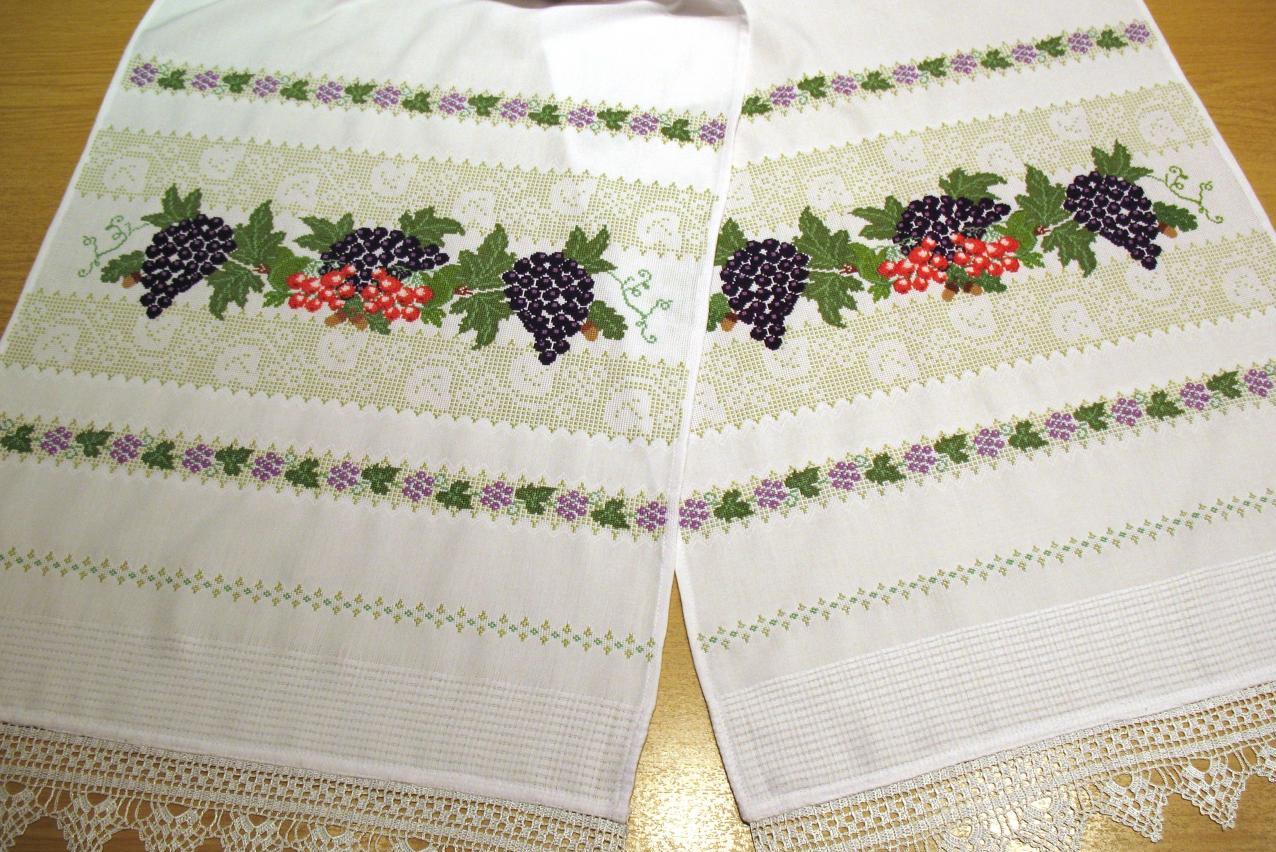 Before buying or making a towel yourself, you need to know the meaning of the symbols depicted on it.
Before buying or making a towel yourself, you need to know the meaning of the symbols depicted on it.
Kalina . An ancient Slavic symbol that still symbolizes Ukraine. According to many scholars, it comes from the Slavic "circle" - which meant the Sun. Symbolizes the beauty of a woman, her strength and health in wedding themes. Since the berries of the viburnum are bright red, they are considered a symbol of the immortality of the family.
Grapes are a symbol of fertility and wealth, meaning the wish for a young family to have many children, like berries in a bunch of grapes.
Mallow . A feminine sign that embodies beauty and youth.
Lily. Represents femininity, chastity, charm and purity. Previously, it was depicted in such a way that if you turn the flower over, you can see two birds sitting next to each other - an ancient symbol of love. Sometimes roses were embroidered above it, which symbolized fertility.
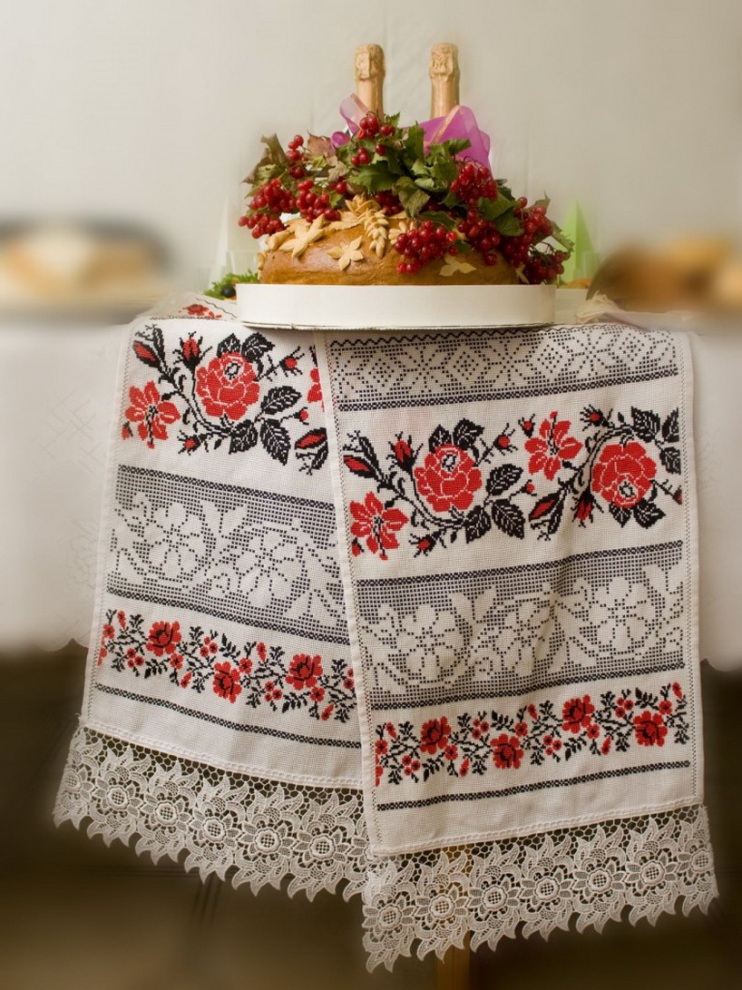 Rose. Symbolizes the sun, continuous movement, rebirth. Most often used in decorating products with embroidery.
Rose. Symbolizes the sun, continuous movement, rebirth. Most often used in decorating products with embroidery.
Poppies. Such flowers are extremely rare on wedding towels. They were embroidered in families where warriors died in battles. And despite the symbol of wealth and unfading female beauty, this is a promise of the newlyweds to continue their lineage to their relatives who fell on the battlefield.
Oak . A tree sacred to Ukrainians since ancient times, a symbol of male energy and strength. It was most often depicted on the groom's towel, with acorns intertwined with viburnum branches, indicating the union of male and female principles.
Hop cones . The meaning of the image of hops is similar to the image of grapes, a symbol of youth, love, and procreation.
A pair of doves or other birds symbolizes family and love. In addition, doves symbolize peace, but on wedding towels they should look at each other or bow their heads to each other. A pair of embroidered birds, with their heads turned in opposite directions, was intended to reject an unwanted groom.
Rooster. A symbol of health, wealth, happiness, and hard work.
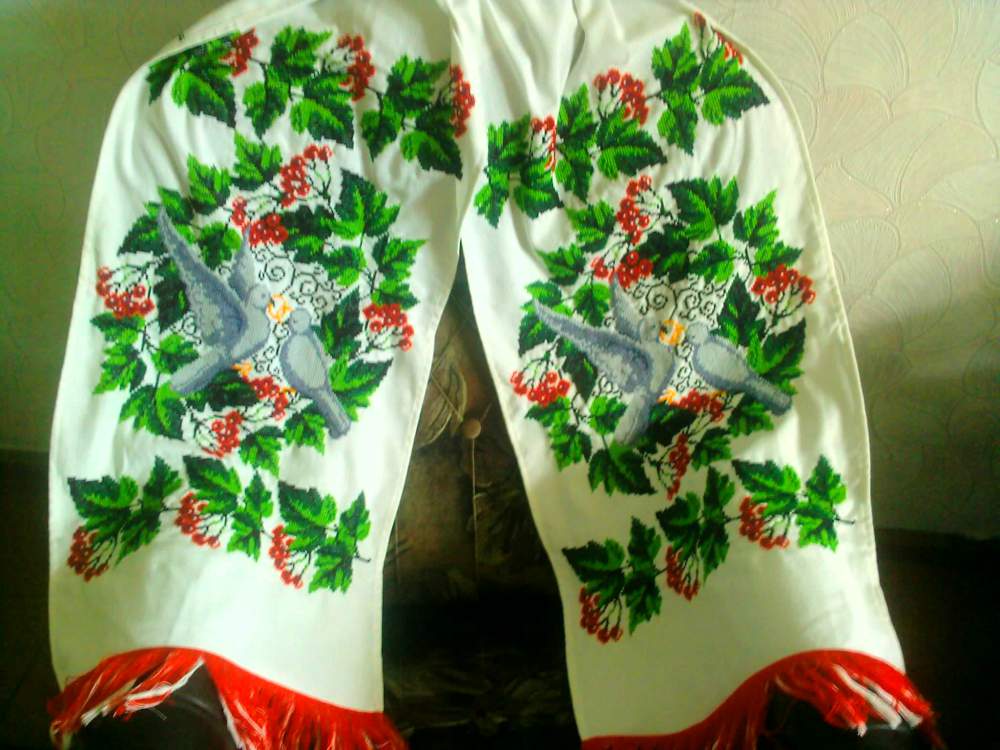 Peacocks . Another existing name for them is firebirds - a symbol of family happiness, birds of the sun. This image symbolizes a source of inexhaustible energy, continuous development and improvement, the creation of a new family. Birds can hold a viburnum sprig in their beaks, and a wedding wreath can shine above their heads.
Peacocks . Another existing name for them is firebirds - a symbol of family happiness, birds of the sun. This image symbolizes a source of inexhaustible energy, continuous development and improvement, the creation of a new family. Birds can hold a viburnum sprig in their beaks, and a wedding wreath can shine above their heads.
The nightingale and the nightingale. These are symbols of pre-wedding mines, indicating unmarried girls and unmarried young men.
Family tree . It was necessarily made with red threads, it looked like a plant with large spreading branches on which flowers bloomed and birds sat. It served as a talisman and indicated a strong connection between different generations, the continuation of the family, happiness in the family. Such a towel was used at the baptism of a child.
In addition to these symbols, wedding towels depicted stars, the sun, geometric and floral patterns. Wedding towels were mainly made double-sided, with images arranged symmetrically. It was considered a great luck to stand on an ancient towel of ancestors who lived a long and happy married life when getting married.
The best day for embroidering a wedding towel was considered Thursday. Before starting work, the girl had to observe a certain ritual: fast, pray before starting work, and be sure to wash her hands.
It was possible to work only with good thoughts and opinions, in no case at this time could one get angry or angry with anyone, since it was believed that this negative energy would be transferred and retained in the work done.
Nowadays, when preparing for a wedding, towels are most often simply purchased in stores, however, knowing the main symbols on them and their meaning will not be superfluous to anyone.

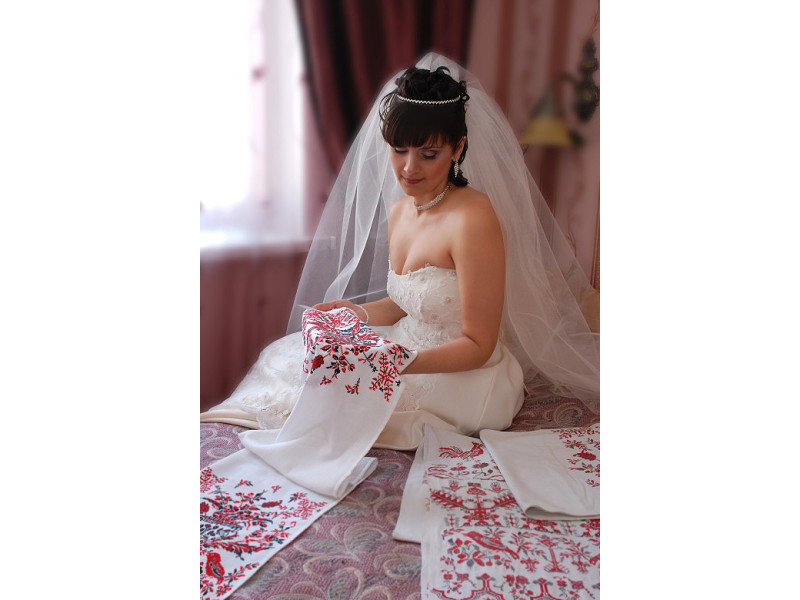
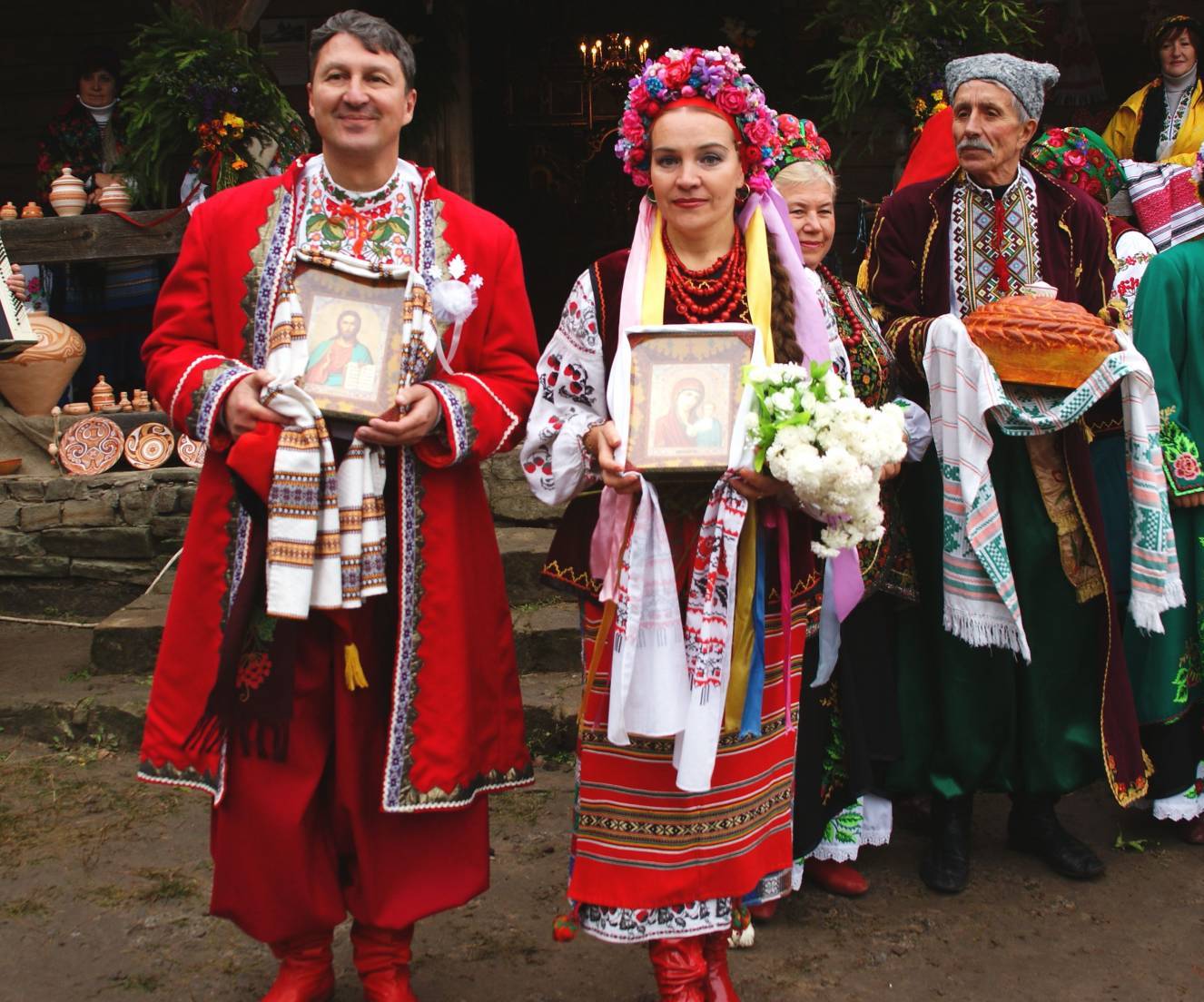
Write a comment